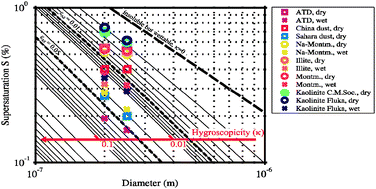Water uptake of clay and desert dust aerosol particles at sub- and supersaturated water vapor conditions
Abstract
Airborne

- This article is part of the themed collection: Physical chemistry of aerosols
* Corresponding authors
a Institute for Atmospheric and Climate Science, ETH Zurich, Zurich, Switzerland
b Laboratory of Atmospheric Chemistry, Paul Scherrer Institut, Villigen, Switzerland
Airborne

 Please wait while we load your content...
Something went wrong. Try again?
Please wait while we load your content...
Something went wrong. Try again?
H. Herich, T. Tritscher, A. Wiacek, M. Gysel, E. Weingartner, U. Lohmann, U. Baltensperger and D. J. Cziczo, Phys. Chem. Chem. Phys., 2009, 11, 7804 DOI: 10.1039/B901585J
To request permission to reproduce material from this article, please go to the Copyright Clearance Center request page.
If you are an author contributing to an RSC publication, you do not need to request permission provided correct acknowledgement is given.
If you are the author of this article, you do not need to request permission to reproduce figures and diagrams provided correct acknowledgement is given. If you want to reproduce the whole article in a third-party publication (excluding your thesis/dissertation for which permission is not required) please go to the Copyright Clearance Center request page.
Read more about how to correctly acknowledge RSC content.
 Fetching data from CrossRef.
Fetching data from CrossRef.
This may take some time to load.
Loading related content
